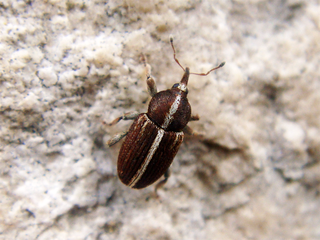
The beetle subfamily Curculioninae is part of the weevil family Curculionidae. It contains over 23,500 described species in 2,200 genera, and is therefore the largest weevil subfamily. Given that the beetle order (Coleoptera) contains about one-quarter of all known organisms, the Curculioninae represent one of the – if not the – most successful radiations of terrestrial Metazoa.
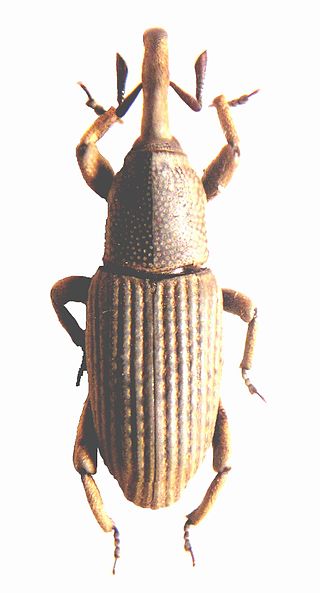
The insect tribe Stromboscerini is part of the weevil family Curculionidae, subfamily Dryophthorinae. It is a small and little-known weevil group. Alonso-Zarazaga & Lyal (1999) treated it as a subfamily.
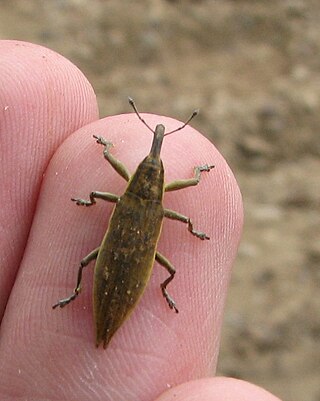
Lixinae is a subfamily of true weevils, included in the Molytinae in many older treatments. They are mainly root feeders, although some develop in flower buds or stems. Several species are used in biological control of invasive weeds, namely knapweeds (Centaurea).
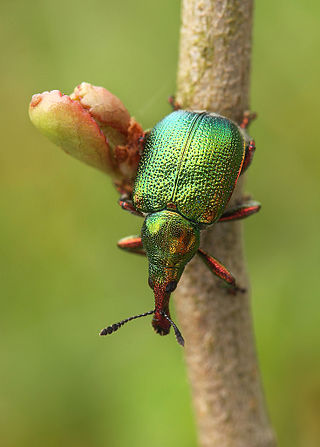
The tooth-nosed snout weevils, Rhynchitidae, are small beetles that are usually found in vegetation. They usually use buds, fruits, or seeds for oviposition. The tooth-nosed snout weevils receive this name due to the teeth on the edges of their mandibles.

The Entiminae are a large subfamily in the weevil family Curculionidae, containing most of the short-nosed weevils, including such genera as Entimus, Otiorhynchus, Phyllobius, Sitona, and Pachyrrhynchus. In comparison with their stunning diversity, only a few of these weevils are notorious pests of major economic importance. Entimines are commonly encountered in the field, including urban environments, and abundant in entomological collections.

Polydrusini is a weevil tribe in the subfamily Entiminae.

Zygopini is a tribe of twig and stem weevils in the beetle family Curculionidae. There are more than 20 genera and at least 250 described species in Zygopini. 83 species are currently known from the 11 genera occurring north of South America, 8 genera occur exclusively in South America, and 2 are recorded from Africa.
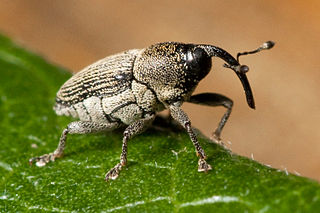
Apostasimerini is a tribe of flower weevils in the family of beetles known as Curculionidae. There are over 240 genera and nearly 1700 described species in Apostasimerini.

Hadroplontus is a genus of minute seed weevils in the family of beetles known as Curculionidae. There are at least two described species in Hadroplontus.
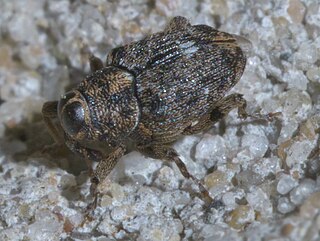
Conoderinae is a subfamily of true weevils in the beetle family Curculionidae. There are more than 210 genera in 15 tribes, and about 2,400 described species in Conoderinae. The thirty-nine extant genera of Conoderinae known to occur in North America, Central America, and the Caribbean are reviewed based on external morphology.

Macrorhyncolus is a genus of true weevils in the family of beetles known as Curculionidae. There are about five described species in Macrorhyncolus.

Myllocerus is a genus of oriental broad-nosed weevils in the beetle family Curculionidae. There are at least 330 described species in Myllocerus.

Rhinoncomimus is a genus of minute seed weevils in the family of beetles known as Curculionidae. There are about eight described species in Rhinoncomimus.

Rhinusa is a genus of true weevils in the family of beetles known as Curculionidae. There are at least 20 described species in Rhinusa.
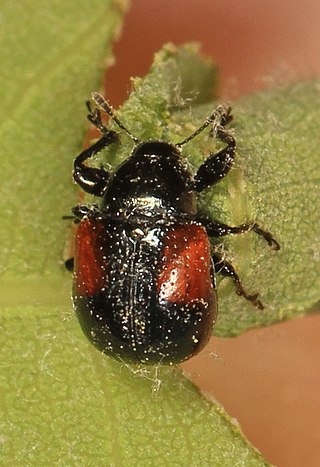
Synolabus is a genus of leaf-rolling weevils in the family of beetles known as Attelabidae. There are at least two described species in Synolabus.

Attelabinae is a subfamily of leaf-rolling weevils in the beetle family Attelabidae. There are at least 20 genera and more than 690 described species in Attelabinae.

Lignyodina is a subtribe of leguminous seed weevils in the family of beetles known as Curculionidae. There are at least 2 genera and about 15 described species in Lignyodina.
Othippiini is a tribe of true weevils in the beetle family Curculionidae. Of the eight genera in Othippiini, only Egiona and Othippia are not monotypic. Acoptus suturalis is the only species of the tribe found in the New World.
Rhinostomus frontalis is a species of weevils, previously placed in a genus called Yuccaborus and known as the yucca weevils.

Apoderinae is a subfamily of leaf rolling weevils in the beetle family Attelabidae. There are at least 20 genera and more than 650 described species in Apoderinae, found in Europe, Asia, and Africa.
















